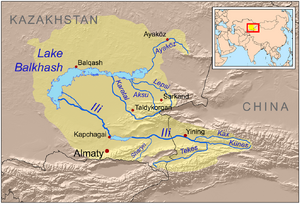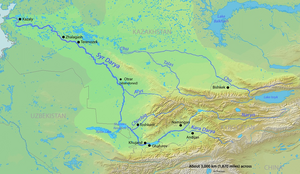Lake Balkhash


Lake Balkhash or Lake Balqash is in southeastern Kazakhstan, in Central Asia.
Jat clans
Origin of name
The present name of the lake originates from the word "balkas" of Tatar, Kazakh and Southern Altai languages which means "tussocks in a swamp".[1]
Location
It is one of the largest lakes in Asia and 13th largest continental lake in the world. It is located in southeastern Kazakhstan, in Central Asia, and belongs to an endorheic (closed) basin shared by Kazakhstan and China, with a small part in Kyrgyzstan. The basin drains into the lake via seven rivers. The major one is the Ili River, which brings the majority of the riparian inflow; others, such as the Karatal, provide both surface and subsurface flow. The Ili is fed from precipitation (largely vernal snow-melt) from the mountains of China's Xinjiang region.
History
From as early as 103 BC up until the 8th century, the Balkhash polity was known to the Chinese as Pu-Ku/Bu-Ku. From the 8th century on, the land to the south of the lake, between it and the Tian Shan mountains, was known as "Seven Rivers" (Jetisu in Turkic, Semirechye in Russian). It was a land where the nomadic Turks and Mongols of the steppe mingled cultures with the settled peoples of Central Asia.[2]
During China's Qing Dynasty (1644–1911), the lake formed the northwestern-most boundary of the Empire. In 1864, the lake and its neighboring area were ceded to Imperial Russia through the Sino-Russian Treaty. With the dissolution of the Soviet Union in 1991, the lake became part of Kazakhstan.
Mythological account of Jata
Hukum Singh Panwar writes:[3] No less important and gratifying, in our search for variants of Jat is our discovery of its earliest mention among the Sanakadicas. They were seven in number-Sananda, Sanatana, Sanantakumar, Jata197, Vodu or Vodhu, etc. All of them are said to be the real as well as mind-born sons of Brahma (from Sapta Sindhu) and they along with many others, went to see Bhagwan Vishnu in Narayanpura, also called Vairavati or Vairamati in the northern parts of Toyambudhi on the sea of fresh water (Mansarovar?) in the Svetdwipa198 (Sivalaks) also known as Saka-dwipa after its conquest and settlement in it by the Sakas199. As a hunter, tempted to chase a musk-deer on and on, ultimately gets at the hill-forests of Central Asia, so our quest for Jat and its alternatives has landed us in the domain of mythology, the curtain of which is grotesquely painted with the legends of Brahma, Vishnu etc., with the back-drop of the Kailash' or mount Meru. It has been said that what is mythological legend today may be history tomorrow, and what is history today may be legend tomorrow. We raise the curtain of mythology and discover that of the seven supposed sons of Brahma, one was Jata (जट), who is represented by the Vishnuites to have led so many to the svet-dwipa for the 'darshan' of Lord Vishnu. This has led us to speculate: was this Jat the same Jat, who, in the presence of Brahma, was made a General on the occasion to defeat and drive away the Asuras from the Sapta Sindhu?
The Jats:Their Origin, Antiquity and Migrations: End of page 354
Incidentally, we learn that the region of the new settlement of Brahma's sons along with their followers was known as Gete2OO which includes a homonymous mountain, known by its ethnonym, Jityam Tau201. This fertile territory enclosed by Sogdiana, Kashgar, lake Balkhash and the Aral Sea, was sensu stricto known as Gete in very remote period202. It was the Saptanada (Sapta Sindhu) of Rahul Sankritayana203, the Jiti-su204 of ancient Turks and Mongols, the Semiryecheye205 of the Russians and the Jatah of Changez Khan206, Tamer Lane (Tamur Ling). All the names, except Jatah and Gete, signify 'land of seven rivers', (now Krighizia). The plethora of these names is not merely homophonic acrobatics but a reality. Sankritayana even suggests that Sapta Sindhu was the original name of the country of Gete and he 207 finds the Scythian (Saka) tribes occupying the region from the middle of the 3rd millennium B.C. upto practically the middle of the 1st millennium B.C. This is the very country of the Massagetae whom Toynbee208 identifies with the Jats. On seeing one thing we are, however, reminded of others connected with it. It is worth mentioning here that the period of the saka (Scythian) occupation of Gete synchronizes with the occupation of the Indus Valley by the Gut or Guti (Goth, Jat), the Panis, the As or Ass (Assii or Asikas), the Dax or Tax209 etc. who are identified With the Saka (Scythian) tribes by a number of scholars21O and with Taxak or Takshak (Tak + Saka) Jats by us.
Notable persons
External links
References
- ↑ Balkhash in Etymological dictionary of Max Vasmer (in Russian)
- ↑ Soucek, Svat (2000) A History of Inner Asia, Princeton: Cambridge University Press, p. 22.
- ↑ The Jats:Their Origin, Antiquity and Migrations/Jat-Its variants , 354-355

